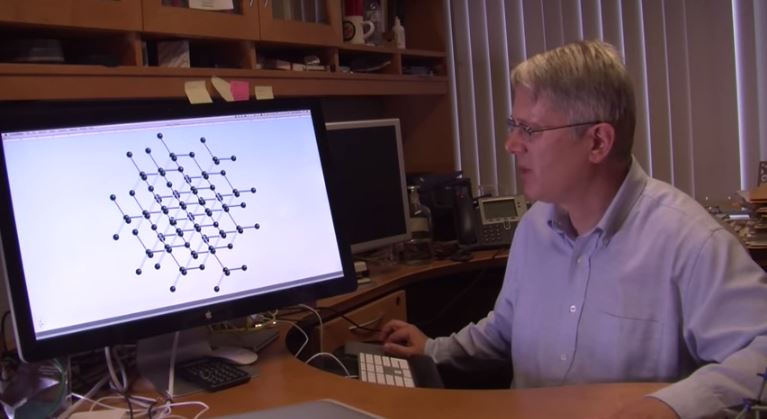BTN.com staff, October 12, 2014
In a world full of chaos, chemistry researchers at Penn State are trying to create some order. In the process, they may have discovered one of the strongest materials in the world.
It all starts with benzyne and diamond nanothreads. The end result could be the material we use to build space elevators.
Confused yet? Penn State chemistry professor John Badding, who?s heading up the effort, can explain.
?My research has an element of high pressure from the very beginning. My interest is in using pressure to find new materials,? he said.
For example, he has done extensive work with benzyne - an organic chemical compound classified as a hydrocarbon.
?For many years I?ve been studying it, with the hope of making something interesting out of it,? Badding said. ?We made what chemists would call disordered material. There was no recognizable order or tremendously interesting about the structure. And I always failed.
?Then [grad student] Tom Fitzgibbons came along, and he wanted to study this material, benzyne. He was the first one who wanted to make bigger amounts. In contrast to all our other experiments, we got order. Which turned out to be a pretty big discovery.?
In the chemistry world, achieving order means finding discernible patterns in atoms.
?It?s like having marbles strewn all over your floor in a haphazard pattern,? Badding explained. ?If the marbles had order, they?d have a pattern. They would be lined up in a straight row, or a rectangle.?
Making order out of benzyne, it turns out, produces a substance that?s of great value to just about any industry that involves manufacturing: an incredibly strong material (hence, ?diamond? nanothreads) that?s also exceptionally lightweight. It?s a structure that?s never been seen before, carrying incredible potential.
?This idea of ultra-strong lightweight materials is growing fast,? said Fitzgibbons, the grad student behind the discovery. ?Everybody?s wanting even lighter than any metal will give you. Carbon is proving to facilitate that.?
For Fitzgibbons, the discovery was the culmination of a study funded by the Department of Energy and its Energy Frontier Research Center. That led him to collaborate with the Carnegie Institution in Washington, D.C., and took him to stations like the Oak Ridge National Laboratory in Tennessee.
?Tom came back and says, ?We found order in this material.? We said, ?Oh my god,?? Badding said.
It became the basis of his Ph.D. thesis and his graduation from the Penn State chemistry department. A paper on the team?s research was published last month in the journal Nature Materials.
It also catapulted Fitzgibbons to a position at Dow Chemicals as soon as he graduated from Penn State in June. ?He interviewed with them, and they offered him the job the next day,? said a proud Badding.
The discovery leads scientists to think about what the future could hold for this type of material. And the term ?space elevator? has even been mentioned. It?s basically what it sounds like: a vertical tube that could transport people and objects long distances through turbulent conditions, like the Earth?s atmosphere.
?Obviously, that?s kind of an out-there idea,? Fitzgibbons said.
More realistically, Fitzgibbons foresees the compound being used in conjunction with more traditional substances.
?Where I see it going is composite materials, where you can use less of other materials,? he explained. ?Or materials that are not as strong on their own. That?s the beauty of starting with something as simple and easy to functionalize as benzyne. Make them at lower pressures, make more of the material. Be able to tie it into other materials.?
?The lighter or stronger your plane or car or bike or whatever, the better,? Badding added. ?That?s important in an age when we are concerned about energy use.?
Badding warned against the idea of thinking this discovery will change the world overnight.
?We?re not going to be using this thing for cars and planes in even five years,? he said. ?It might be 20 to 30 years, maybe never. You never know.?
For now, Badding and his team of students will keep studying their discovery and what it can do for the world. Fortunately, they feel secure that they?ll be allowed to do that for a long time to come. The U.S. Department of Energy recently announced it would renew funding for the project, and Penn State continues to support it in a number of ways.
?Penn State facilitates everything because they provide the structure, the framework in which we work,? Badding said. ?None of this could have happened without all that.?
By Matthew Wood
[display-posts tag="livebig-penn-state" posts_per_page="7"]







